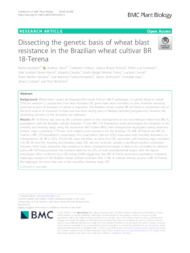Dissecting the genetic basis of wheat blast resistance in the Brazilian wheat cultivar BR 18-Terena.
Dissecting the genetic basis of wheat blast resistance in the Brazilian wheat cultivar BR 18-Terena.
Author(s): GODDARD, R.; STEED, A.; CHINOY, C.; FERREIRA, J. R.; SCHEEREN, P. L.; MACIEL, J. L. N.; CAIERAO, E.; TORRES, G. A. M.; CONSOLI, L.; SANTANA, F. M.; FERNANDES, J. M. C.; SIMMONDS, J.; UAUY, C.; COCKRAM, J.; NICHOLSON, P.
Summary: Background: Wheat blast, caused by Magnaporthe oryzae Triticum (MoT) pathotype, is a global threat to wheat (Triticum aestivum L.) production. Few blast resistance (R) genes have been identified to date, therefore assessing potential sources of resistance in wheat is important. The Brazilian wheat cultivar BR 18-Terena is considered one of the best sources of resistance to blast and has been widely used in Brazilian breeding programmes, however the underlying genetics of this resistance are unknown. Results: BR 18-Terena was used as the common parent in the development of two recombinant inbred line (RIL) F6 populations with the Brazilian cultivars Anahuac 75 and BRS 179. Populations were phenotyped for resistance at the seedling and heading stage using the sequenced MoT isolate BR32, with transgressive segregation being observed. Genetic maps containing 1779 and 1318 markers, were produced for the Anahuac 75 × BR 18-Terena and BR 18- Terena × BRS 179 populations, respectively. Five quantitative trait loci (QTL) associated with seedling resistance, on chromosomes 2B, 4B (2 QTL), 5A and 6A, were identified, as were four QTL associated with heading stage resistance (1A, 2B, 4A and 5A). Seedling and heading stage QTL did not co-locate, despite a significant positive correlation between these traits, indicating that resistance at these developmental stages is likely to be controlled by different genes. BR 18-Terena provided the resistant allele for six QTL, at both developmental stages, with the largest phenotypic effect conferred by a QTL being 24.8% suggesting that BR 18-Terena possesses quantitative resistance. Haplotype analysis of 100 Brazilian wheat cultivars indicates that 11.0% of cultivars already possess a BR 18-Terenalike haplotype for more than one of the identified heading stage QTL. Conclusions: This study suggests that BR 18-Terena possesses quantitative resistance to wheat blast, with nine QTL associated with resistance at either the seedling or heading stage being detected. Wheat blast resistance is also largely tissue-specific. Identification of durable quantitative resistances which can be combined with race-specific R gene-mediated resistance is critical to effectively control wheat blast. Collectively, this work facilitates markerassisted selection to develop new varieties for cultivation in regions at risk from this emerging disease.
Publication year: 2020
Types of publication: Journal article
Unit: Embrapa Wheat
Observation
Some of Embrapa's publications are published as ePub files. To read them, use or download one of the following free software options to your computer or mobile device. Android: Google Play Books; IOS: iBooks; Windows and Linux: Calibre.
Access other publications
Access the Agricultural Research Database (BDPA) to consult Embrapa's full library collection and records.
Visit Embrapa Bookstore to purchase books and other publications sold by Embrapa.

